National Aeronautics and Space Administration
Goddard Space Flight Center

Sun-Earth Day 2010: Magnetic Storms
Issue #70: The Great Solar Superstorm of 1859
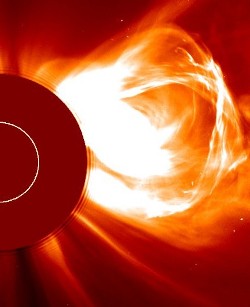
Figure 1: A coronal mass ejection seen by the SOHO satellite.
150 years ago, the sun let loose a powerful superstorm - can it happen again?
"She ran screaming down the street, unable to contain her terror as night was turned into hideous crimson daylight…communications networks failed and equipment burst into flame…a bustling city lost power, trapping thousands of people inside elevators…satellites malfunctioned and in an instant millions of people lost touch with critical services, doctors and children."
These are not the theatrical elements of some B-grade science fiction movie, but just a few events that played out during severe solar storms of the past. As the current sunspot cycle draws to a close, the tally of solar storms vouches for the sun's stormy nature. Over 21,000 flares and 13,000 coronal mass ejections (CMEs) have exploded from the sun's magnetically active surface since 1996. Solar storms cause spectacular aurora borealis to take the skies, dazzling and humbling all who were fortunate to be in the right geographic locals. But today, these storms pass by with far more impact, not only as fodder for folklore, but as costly lessons that our technology is still not immune from an ages-old phenomenon. Fortunately, apart from the X-34 superflare on November 4, 2003 and the powerful geomagnetic storms on July 15, 2001 and October 29, 2003, this solar activity cycle was actually rather well-behaved. Once every few centuries, however, the sun erupts with a major event unlike anything we have experienced in recent memory.
Between August 28 - September 6, 1859, humans experienced one of the most spectacular solar storms in the last 450 years. Reconstruction of this event from historical data has led space weather researchers in recent years to classify it as a Superstorm. Here's what it was like:
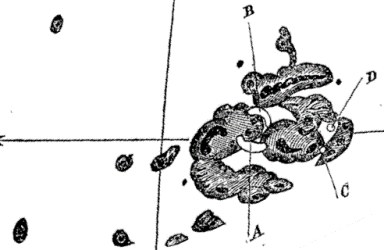
Figure 2: Richard Carrington drew this sketch of the white-light flare, shown as the two white semi-circles in the complex sunspot group.
The Superstorm of 1859
The first CME arrived arrived on August 28th and was even by modern accounts a major storm in its own right. Visible in the Northern Hemisphere as far south as Cuba. But the real excitement came with the second CME launched a few days later on September 1. Astronomer Robert Carrington and amateur astronomer Rodger Hodgson had been observing the sun from their observatories near London, England, when both were fortunate to spot a rare, and powerful white-light flare just before Noon. This flare also launched the second CME in the direction of Earth.
The second CME had all the right things going for it. It was fast; it had the right magnetic field orientation, and like a snow plow it was a dense wall of plasma second to none. In just over 17 hours, it swept across the entire inner solar system. At 05:00 UT, an insignificant part of its magnetized plasma brushed by Earth's magnetic field. Within minutes, the entire sun-facing magnetic hemisphere was disrupted and compressed until it reached Earth's tenuous outer atmosphere. The ozone layer was instantly reduced by 5%, and would take several years to recover. The rest of Earth's magnetic field in the night-side became a complex, tangled mass of field lines trying to sort themselves out across a trillion cubic kilometers of space.
The magnetic upheaval in space, utterly invisible to the human eye, continued for a day or more, while from the ground spectacular aurora were seen as far as the equatorial climates of Central America and Bombay, India. In its wake, the Van Allen belts vanished as did Earth's entire plasmasphere, raining energetic particles into the upper atmosphere causing crimson-red aurora worldwide.
Predictably, people saw cities on fire, or specters dancing in glee over some celestial battle. They stood and gawked by the millions, or wrote detailed eyewitness descriptions to their newspapers. In this pre-Civil War era, the only technological impact was telegraph outages and instrument fires, but the scope was world-wide and reached from Scandinavia to Australia.
Today, such an event would be without any historical precedent. At no other time has the web of technology so completely engulfed our day-to-day lives, from the scale of our national electrification grid, to satellites orbiting in space, and human activity in the air and in space. Literally billions of people are now in close personal contact with the most space weather-prone technologies. Luckily, Superstorms seem to be rare events for a star like our sun.
A Tale of Ice and Fire
Deep within ice crystals in Greenland and Antarctica, nitrate atoms had collected in trapped gases since the year 1561. Scientists Michael Smart, Donald Shea and Kennith McCracken at the Air Force Research Lab and the University of Maryland discovered that nitrate concentrations rose and fell suddenly with solar activity. They were a particularly good barometer of powerful radiation storms called 'Solar Proton Events'. In the 450 years covered by the record, the biggest of these SPEs was the 1859 Superstorm event. Slightly weaker storms, however, are far more numerous.
In recent times, the SPEs that occurred on August 4, 1972 and March 1991, have been used by the satellite industry as the worst case SPE events. Since 1561, there have been 19 events more intense than these, with an average arrival interval of 23 years. The overall pace of their arrival is not uniform in time. These two events are the only major ones recorded since 1965. By comparison, during the same 40-year periods between 1850-1890 and between 1890-1930 there were 10 events more intense than the one on August 1972. The current 40-year period has been the least productive in generating large SPEs since as far back as 1670 during the Maunder Minimum! If you wanted to build satellites that endure the rigors of the space environment, Cycle 23 and some of the severe storms during the last 50 years, were probably the wrong examples to use as a 'tall pole' for how bad things can get.
So, what would a modern-day Superstorm be like? There isn't a single prediction that shows one of these storms is in our immediate future, but what would happen if Cycle 24 were to pull a surprise?
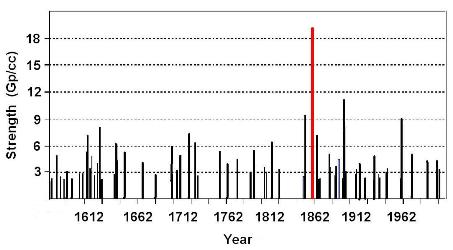
Figure 3: Ice core data shows a strong spike (red bar) in the atmospheric nitrate (NOx) abundances during the 1859 storm, along with lesser spikes for many other storms since 1500.
A Modern Superstorm
The year would be close to sunspot maximum, sometime between 2010 and 2012. The most favorable months would be March or September during the Equinoxes. A large, angry-looking sunspot would be transiting the solar meridian with many astronomers worried in the days leading up to the event. Perhaps a few baby X-10 flares and a dozen more X-1 flares would signal the hopelessly tangled magnetic conditions running amuck. Each flare would cause notable short-wave blackouts.
Unless this storm were also launched by a white-light flare visible to lucky amateur and professional solar observers, the armada of solar research satellites such as Hinode, STEREO, and the Solar Dynamics Observatory would be among the first to see it. An intense blast of X-rays and energetic particles would black-out every sensor system in space on the daylight side of Earth. The massive pulse of x-rays would destroy the D-layer and cause instant shortwave blackouts across the sun-side hemisphere. The ozone layer would be depleted by 5 or 10%, causing a spike in skin cancer events for the statistically unlucky.
If it were a double-barreled CME, the first one would have dazzled us with spectacular aurora in the Northern Hemisphere rivaling the Halloween 2003 storms. The second one, launched perhaps a day later, would have a frictionless interplanetary medium to navigate and arrive at Earth within 15-20 hours. A tremendous pulse of energetic protons accelerated by shockwaves in the CME would race ahead of the plasma wall, and instantly invade satellite circuitry. Thousands of satellite operations anomalies would be recorded, of which a fair fraction would be fatal. The protons would enter the atmosphere and cause nuclear interactions, liberating high-speed neutrons in showers that would reach the ground. Computer systems would crash as 'Sudden Event Upsets' violate the integrity of binary information stored in memory. The loss of some satellites, and malfunctions to others, could at a minimum escalate within hours to become a $20 billion loss in revenue and resources. Defense Department satellites would also be blinded to varying degrees, and the GPS system would report highly inaccurate positions for a day or more. Precision navigation, oil drilling, search and rescue, and military bombing would come to a halt, with potentially disasterous consequences.
Despite these events, we could luck-out. Half the time, the magnetic orientation of CMEs is 'north directed' so that the interaction with Earth's magnetic field is weak. The storm would pass with only moderate impact. But without some cosmic bon homie, we are in for another exciting ride.
According to John Kappenman, an electric power engineer at MetaTech Corporation, a modern-day solar storm as severe as the one experienced in 1921 would affect 150 million people across North America in a blackout without any precident. Insidious magnetic storm currents would damage transformers for which no replacements are available, and have to be manufactured overseas since no domestic suppliers exist. According to some estimates, during a superstorm event, the daily cost could exceed about $30 billion in lost salaries, spoiled food, foundry closures and other collateral effects - and this state could persist for a week or more
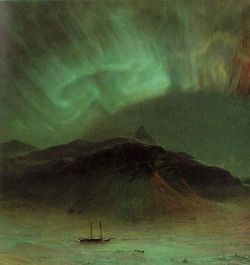
Figure 4: The American painter Frank Church rendered this famous painting 'The Northern Lights' in the early 1860s, perhaps inspited by the 1859 event. (Courtesy: The National Gallery of Art; Smithsonian Institution)
"The End of the World...News at 11:00"
A common feature shared by the earlier storm events since 1850 is the lavish newspaper accounts describing them. On March 25, 1940, the Boston Globe ran a banner headline 'U.S. Hit by Magnetic Storm' in 2-inch lettering above the fold. They banked heavily on the average reader knowing what a 'magnetic storm' was. During those years, most people did! Since the 1950's, solar storms have all but vanished from the front page, and the stories have moved deeper into the daily papers. They have also been shorn of any details of specific incidents, so their human impact has been muted. For instance, the historic March 13, 1989 storm blacked-out Quebec for 12 hours, cost several billion dollars and a lot of political embarrassment in Canada. It was a Cosmic Event that was not even mentioned in the major US papers of the day.
Ironically, although we are far more vulnerable to major solar storms since the 1960's, they now tend to be regarded by the Public for their entertainment value and night-time spectacle, rather than their historically-recognized capacity to do serious harm. Did you know that the solar storm of September 24, 1946 caused navigation errors that led to a famous plain crash in Gander, Newfoundland, which killed 26 passengers and crew?
The previous sunspot cycle was actually quite eventful. It was a costly cycle of satellite outages and losses totaling by some estimates nearly $3 billion. Satellite industry trade journals spoke about insurance brokers struggling under massive billion-dollar annual payouts. Collectively, our commercial satellites lost about 3 years of lifespan at an eventual cost of tens of billions in lost profit. There were also several near-misses with US electrical power grids pushed to near-blackout conditions but rescued in the nick of time. Along the way, we also heard about miraculous NASA satellites such as SOHO, ACE, IMAGE and Polar that could collectively watch solar storms from cradle to grave. 'Space Weather' had arrived as a news-worthy subject, though in the end it was a dramatic human-interest topic that didn’t sell many books.
Our next national blackout could come as a complete surprise even though the necessary technology to alert us to impending problems was well-known and heavily used during the previous cycle. If the cosmic dice fall the wrong way, we may well look back at Cycle 23 as 'the good old days'.
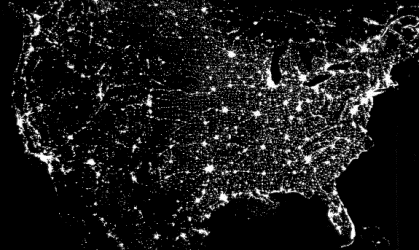
Figure 5: A night time view of the United States showing city lights from coast to coast.
"And the good news is...."
According to research by Brad Schaefer at Yale University, it is not uncommon for mild-mannered stars like our sun to explode in a 'superflare' from time to time. By comparison, these superflares are millions of times more intense than the 1859 event. In 2000, he and his colleagues identified nine solar-type stars such as Kappa Ceti, with flares up to 100 million times more powerful than any seen on the sun to date. Their studies suggest superflares can occur every 100 years or so in otherwise ordinary, stable, Main Sequence stars.
If the sun were to have such an eruption, it could possibly cause mass extinctions, plunge the Earth into brief heat wave, flood the planet with gamma and X-rays, melt electronics in orbiting satellites, cause global auroras and wipe out all of the ozone that protects the Earth from harmful ultraviolet radiation. "The loss of ozone could kill the food chain and probably cause mass extinctions," Schaefer said.
But don’t' worry. The 1859 Superstorm seems to be the best our sun can muster. Evidence from cosmic ray tracks in moon rocks suggests that the sun has not produced too many of these superflares during the last 5 million years. Still more ancient solar superflares would have melted the ice on the moons of Jupiter and left smooth frozen plains, and we don't see any traces of them, either!
The reason that the sun has these disturbances in the first place has less to do with the immense gravity of this nearby star, which keeps our earth in orbit, but much more to do with another force of nature that you have daily experience with in many different guises....Magnetism!
The Sun-Earth Connection
The realization that the the sun is a star whose magnetic phenomena can cause problems for humans and human technology even from a distance of 150 million kilometers!
Space Math Connection:
These problems are available at Space Math @ NASA (http://spacemath.gsfc.nasa.gov)
Monster Sunspots! [Problem 107]
Students will determine the scale of three images of large sunspots including the Carrington Spot, and order the spots in increasing size [Grade 5-8; = Skills:=20 image scales; metric measurement]
Solar Storms: Sequences and probability [Problem 175]
Students work out all the ways that three flares and two CMEs can occur on a Friday of a week [Grade 5-8; Skills: Probability, counting, creating sequences]
Solar Storm Timeline [Problem 198]
Students read an essay and determine the sequence of events during a solar storm[Grade 4-6; Skills: critical reading; time arithmetic]
Magnetic Math [Book]
This book features 40 mathematics problems related to the study of magnetism. [Grade 4-12; Skills: hands-on labs; pre-Algebra, Geometry, Algebra I, Algebra II]
References:
Odenwald, S. F. and Green, J., 2008, "Bracing for a Solar Superstorm", Scientific American, August 2008, pp. 80-85
Odenwald, S. F., 2008, "The Coming Solar Superstorm", Astronomy, September, 2008, pp 34-39
- SED-2005 Solar Observatories TTT 1-30
- SED-2006 - First observations of the sun by humans - TTT 31-47
SED-2007 - Solar Science:
- TTT 48 - The Sun from Cradle to Grave
- TTT 49 - Solar Energy
- TTT 50 - Ancient Sunlight
- TTT 52/6 - Solar activity and features
- TTT 57 - The Heliosphere
SED-2008 - Space Weather Around the World:
- TTT 58 - Why is the sun's corona hot?
- TTT 59 - Where did all the neutrinos go?
- TTT 60 - Where does the sun's magnetic field come from?
Credits:
Dr. Sten Odenwald (Author - Hinode)
View past issues
NASA Fact
A sunspot can have a magnetic field with a strength up to 10,000 Gauss, but they live very short lives!
